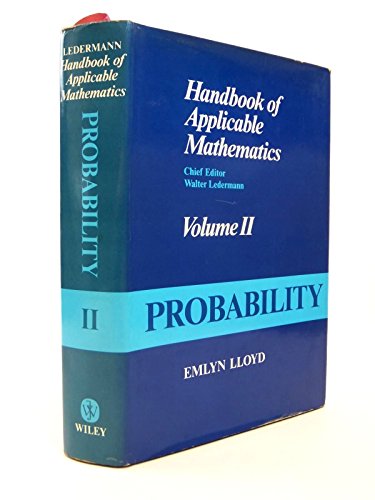
Synopsis
Probability is the measure of the likelihood that an event will occur.[1] Probability is quantified as a number between 0 and 1 (where 0 indicates impossibility and 1 indicates certainty).[2][3] The higher the probability of an event, the more certain we are that the event will occur. A simple example is the tossing of a fair (unbiased) coin. Since the coin is unbiased, the two outcomes ("head" and "tail") are equally probable; the probability of "head" equals the probability of "tail." Since no other outcome is possible, the probability is 1/2 (or 50%) of either "head" or "tail". In other words, the probability of "head" is 1 out of 2 outcomes and the probability of "tail" is also, 1 out of 2 outcomes. These concepts have been given an axiomatic mathematical formalization in probability theory (see probability axioms), which is used widely in such areas of study as mathematics, statistics, finance, gambling, science (in particular physics), artificial intelligence/machine learning, computer science, game theory, and philosophy to, for example, draw inferences about the expected frequency of events. Probability theory is also used to describe the underlying mechanics and regularities of complex systems.[4] Wikipedia
"synopsis" may belong to another edition of this title.
Search results for Probability (v. 2) (Handbook of Applicable Mathematics)
Probability (Handbook of Applicable Mathematics Volume 2)
Seller: BooksRun, Philadelphia, PA, U.S.A.
Hardcover. Condition: Fair. Volume 2. The item might be beaten up but readable. May contain markings or highlighting, as well as stains, bent corners, or any other major defect, but the text is not obscured in any way. Seller Inventory # 0471278211-7-1
Probability
Seller: Better World Books, Mishawaka, IN, U.S.A.
Condition: Good. Volume 2. Former library book; may include library markings. Used book that is in clean, average condition without any missing pages. Seller Inventory # 582757-6
Probability
Seller: Better World Books, Mishawaka, IN, U.S.A.
Condition: Good. Volume 2. Used book that is in clean, average condition without any missing pages. Seller Inventory # 48619750-6
Probability (Handbook of Applicable Mathematics Volume 2)
Seller: Zubal-Books, Since 1961, Cleveland, OH, U.S.A.
Condition: Good. 470 pp., hardcover, ex library else text clean and binding tight. - If you are reading this, this item is actually (physically) in our stock and ready for shipment once ordered. We are not bookjackers. Buyer is responsible for any additional duties, taxes, or fees required by recipient's country. Seller Inventory # ZB1328934
Handbook of Applicable Mathematics: Probability (Volume 2)
Seller: Anybook.com, Lincoln, United Kingdom
Condition: Fair. Volume 2. This is an ex-library book and may have the usual library/used-book markings inside.This book has hardback covers. In fair condition, suitable as a study copy. No dust jacket. Please note the Image in this listing is a stock photo and may not match the covers of the actual item,1300grams, ISBN:0471278211. Seller Inventory # 5361063
Handbook of Applicable Mathematics, Volume II: Probability
Seller: Tiber Books, Cockeysville, MD, U.S.A.
Hardcover. Condition: Very Good. Large 8vo, hardcover. Vol. 2: Probability. Vg+ condition in vg dj. NOT ex-library. Contents bright & clean, binding firm; dj glossy, very slightly spine-faded (title lettering still fully legible). 450 pp. Seller Inventory # 1110419.10
Probability: 2
Seller: Libro Co. Italia Srl, San Casciano Val di Pesa, FI, Italy
Rilegato in Tela. Condition: fine. West Sussex, 1980; clothbound, pp. 470, cm 17x25. Libro. Seller Inventory # 3367154
